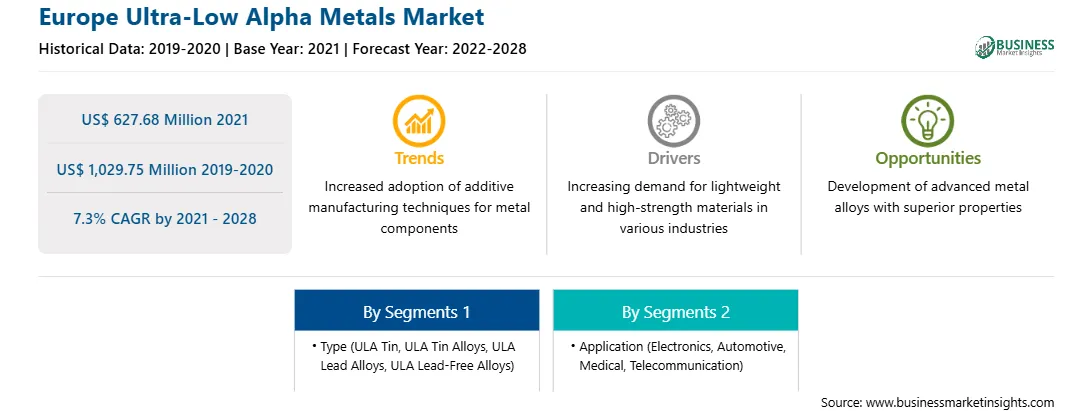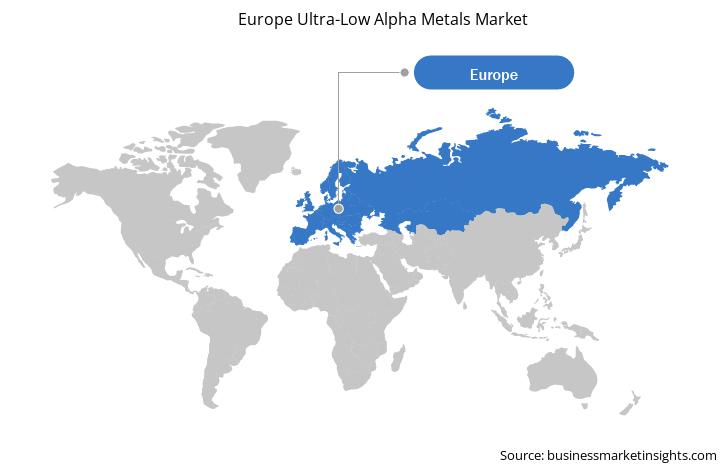The Europe ultra-low alpha metals market is a highly fragmented market with the presence of considerable regional and local players providing numerous solutions for companies investing in the market arena. For the past few years, several metals such as lead (Pb), are being extensively used in the production of electronic devices to boost the functionality of such devices. However, the implementation of regulations by government bodies on the use of such unsafe metals in electronic devices has led to increased adoption of substitute metals. As a result, the companies involved in the production of electronic devices have focused their attention on the deployment of ultra-low alpha metals in their devices. Apart from government regulations on the use of toxic substances, the use of heavy metals in electronic products has also been prohibited under the Restriction on Hazardous Substances (RoHS) Directive. Such regulations and policies framed by governments are expected to boost the growth of the ultra-low alpha metals market. Ultra-low alpha metals offer the provision of production based on materials that are free from hazardous substances. Other than this, the availability of different types of ultra-low alpha solders is broadening the scope of choosing alloys depending on the specific purpose. Hence, strict government regulations on the use of hazardous substances in electronic equipment are expected to stimulate the growth of the ultra-low alpha metals market.
In Europe, the UK reported a huge number of COVID-19 cases, which led to the discontinuation of several business operations, including ultra-low alpha metals manufacturing activities. The disruption in the supply chain with volatility in raw material pricing and sourcing in the initial weeks of lockdown has impacted the industrial products and processes. However, as the economies are planning to revive their operations, the demand for ultra-low alpha metals is expected to rise in Europe. However, the focus on just-in-time production is another concerning factor hindering market growth. The increasing demand for advanced industrial materials backed by the growth of end-use industries such as electronics, aerospace & defense, automotive, medical, and telecommunication is expected to contribute to the market's growth. Further, significant investments by prominent manufacturers in advancing ultra-low alpha lead-free alloys are expected to drive the ultra-low alpha metals market.

Strategic insights for the Europe Ultra-Low Alpha Metals provides data-driven analysis of the industry landscape, including current trends, key players, and regional nuances. These insights offer actionable recommendations, enabling readers to differentiate themselves from competitors by identifying untapped segments or developing unique value propositions. Leveraging data analytics, these insights help industry players anticipate the market shifts, whether investors, manufacturers, or other stakeholders. A future-oriented perspective is essential, helping stakeholders anticipate market shifts and position themselves for long-term success in this dynamic region. Ultimately, effective strategic insights empower readers to make informed decisions that drive profitability and achieve their business objectives within the market.

| Report Attribute | Details |
|---|---|
| Market size in 2021 | US$ 627.68 Million |
| Market Size by 2028 | US$ 1,029.75 Million |
| Global CAGR (2021 - 2028) | 7.3% |
| Historical Data | 2019-2020 |
| Forecast period | 2022-2028 |
| Segments Covered |
By Type
|
| Regions and Countries Covered | Europe
|
| Market leaders and key company profiles |
The geographic scope of the Europe Ultra-Low Alpha Metals refers to the specific areas in which a business operates and competes. Understanding local distinctions, such as diverse consumer preferences (e.g., demand for specific plug types or battery backup durations), varying economic conditions, and regulatory environments, is crucial for tailoring strategies to specific markets. Businesses can expand their reach by identifying underserved areas or adapting their offerings to meet local demands. A clear market focus allows for more effective resource allocation, targeted marketing campaigns, and better positioning against local competitors, ultimately driving growth in those targeted areas.

The ultra-low alpha metals market in Europe is expected to grow from US$ 627.68 million in 2021 to US$ 1,029.75 million by 2028; it is estimated to grow at a CAGR of 7.3% from 2021 to 2028. The expanding demand for higher density and lower power requirements has propelled the concept of reducing the dimensions and operating voltages of modern electronic devices. The constant scaling of complementary metal-oxide-semiconductor device technologies has led to miniaturization and shrinkage in the operating voltage of the device transistors. However, the concept has opened new challenges, both from the technology and materials point of view. One such issue is soft error, the temporary malfunction of the device, which is caused by the radiation of high-energy alpha particles. One of the primary sources of alpha particle radiation is the solders which are significantly deployed for joining components in the packaging. Hence, the growing concern toward the soft error issue has led to an increase in demand for ultra-low alpha metals.
Based on type, the ULA lea-free alloys and others segment accounted for the largest share of the Europe ultra-low alpha metals market in 2020. Based on application, the electronics segment accounted for the largest share of the Europe ultra-low alpha metals market in 2020.
A few major primary and secondary sources referred to for preparing this report on the Europe ultra-low alpha metals market are company websites, annual reports, financial reports, national government documents, and statistical database, among others. Major companies listed in the report include Mitsubishi Materials Corporation; Teck Resources Limited; Advanced Manufacturing Services (AMS) Ltd.; Pure Technologies; Honeywell International Inc. and MacDermid Alpha Electronics Solutions.
The Europe Ultra-Low Alpha Metals Market is valued at US$ 627.68 Million in 2021, it is projected to reach US$ 1,029.75 Million by 2028.
As per our report Europe Ultra-Low Alpha Metals Market, the market size is valued at US$ 627.68 Million in 2021, projecting it to reach US$ 1,029.75 Million by 2028. This translates to a CAGR of approximately 7.3% during the forecast period.
The Europe Ultra-Low Alpha Metals Market report typically cover these key segments-
The historic period, base year, and forecast period can vary slightly depending on the specific market research report. However, for the Europe Ultra-Low Alpha Metals Market report:
The Europe Ultra-Low Alpha Metals Market is populated by several key players, each contributing to its growth and innovation. Some of the major players include:
The Europe Ultra-Low Alpha Metals Market report is valuable for diverse stakeholders, including:
Essentially, anyone involved in or considering involvement in the Europe Ultra-Low Alpha Metals Market value chain can benefit from the information contained in a comprehensive market report.